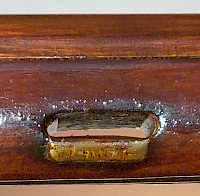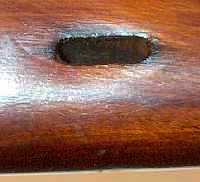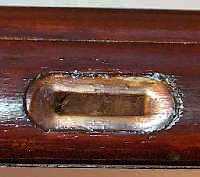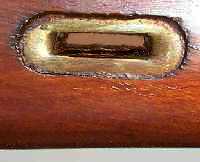





| Soviet M44 All content copyright © 7.62x54r.net Return to Models Introduction |
Overview
In 1943 some 50,000 trials carbines were built specifically for urban combat and tested in battle as the Soviet Army marched through Germany at the close of WWII. They are essentially an M38 with an attached side-folding bayonet and were adopted in 1944 as the "7,62 mm Carbine, Model of the Year 1944", commonly known as the M44 in the US. The M44 is the only model of Mosin Nagant that was produced in significant quantities in the Soviet Union itself after WWII with production ending in 1948. It is also the model most widely duplicated by other countries during the Cold War. As with the M38, most production occurred at Izhevsk with Tula examples being less common and more sought after.
Variations and Features to Look For
Although the M44 did not see a lot of use during WWII it was widely dispersed during the Cold War and there are some interesting and uncommon variations which are sought after by collectors. A brief summary of these follows.
Arsenals and Dates M44 production began at Izhevsk in 1943 one year before official adoption and continued through 1948. The first year of production is uncommon at an estimated 50,000 total and typically bring a premium. All other years are relatively common, but 1947 is a low production year. Tula only made M44s in 1944 and these should be considered uncommon and purchased when found at the price of a typical Izhevsk M44. While there was no known program in the Soviet Union to cut down earlier rifles into M44s one example of a 1904 Izhevsk M44 is known. There are also documented M91/38s which have the bayonet intact. Any carbines with attached bayonets outside of the typical production should be examined closely and probably purchased if the price is not completely out of line.
Receivers By the time the M44 went into production the round receiver had been standard for several years so none were ever built on new hex receivers. However, some were built on older hex receivers from rifles which presumably had barrels which were damaged or worn. Examples from Izhevsk are typically dated 1945. Tula M44s on hex receivers are more readily available than Izhevsk examples, but still not common. There are also M44s on older round receivers, apparently comparable in numbers to the hex M44s. Regardless, any M44 from either arsenal on a non-standard configuration receiver for it's year of production is uncommon and should be acquired if for no other reason than as trading material with other collectors who have an interest in that type of variation. In late 1945 new receivers began to be made in the low wall style which continued to the end of production in 1948.
Stocks M44 stocks come in three primary types as pictured below on this page. Any of the stock types can be found on any date M44 due to the refurbishment process where stocks were replaced or reused on other rifles. No M44 stocks were ever newly made with the screwed on sling slot escutcheons, but this type of stock is often found on M91/38s as they were cut down from M91 stocks. During WWII the rear sling slot escutcheon was eliminated and the front one was converted to a sheetmetal liner in the bottom of the slot only for M91/30s and M38s and this is the first configuration found on M44s. These are less common due to attrition. Post war M44 stocks have full escutcheons both front and rear but they are pressed into the stock rather than screwed on. These can be from original post-WWII production or replacement stocks. Laminated M44 stocks may have been produced late in WWII but most are likely post-war production. They are much more common than M91/30s and M38 laminated stocks and don't bring a huge premium. All stock types can have a variety of repairs and most don't bring a premium or hurt the value of a rifle. M44 stocks with the distinctive "zig zag" splice just behind the rear barrel band are known. There is no variation to speak of among handguards, none of which were laminated, although earlier M38 handguards with brass end caps can occasionally be found on M44s. The majority will have steel end caps. There are distinctive stocks, usually of beech, which are thought to be of Czech origin. They are more common on M91/38s and M91/59s, but are found on Soviet M44s also. There is also at least one Soviet M44 with an unusual stock that is suspected to be of Albanian origin. Both of these varitions are pictured below.
Sights, Bayonets and Barrel Bands There were only minor changes to M44 sights throughout production which are detailed below but don't mean much as far as value or rarity are concerned. Likewise there were changes in the bayonet lug and locking ring but neither major variation is rare. Barrel bands did not change throughout production.
Marks There are a wide variety of unknown marks found on M44s with the Soviet MO double and triple dates being among the more desirable. Soviet trainers are a little known variation with stocks painted black and "YY" marks in various places. Marks associated with other countries are covered below. Due to heavy reworks and sanding during refurbishment clear arsenal marks are seldom found on M44 stocks and are a nice bonus. On the other hand, there are numerous Cyrillic letters and numbers found alone or in circles, squares, and triangles with unknown meanings which don't add any value other than as a curiosity.
Other Countries Soviet M44 carbines were also used by a number of
different countries and can often be identified by additional marks or simply
conditions and features unique to these countries. In general these are less
common, more desirable, and more valuable than typical Soviet refurbished
rifles. Poland, Hungary, Romania and China built their own M44s, known as the
T53 in China, and they are covered on their own pages. However, Soviet M44s with
Eastern European stocks and miscellaneous parts turn up relatively often and are
not particularly rare. M44s with a mix of Chinese parts are less common as
weapons and weapon technology typically traveled west to east and not vice
versa.
Finland Finland captured a limited number of M44s during the Continuation War,
and most known examples are dated 1943. The best known identifier is the SA mark
typically found on the left side of the barrel along the woodline, although
occasionally in other locations on the barrel shank. Other
Finnish marks include a
"D" which indicates the chamber throat has been enlarged for the
Finnish D166 cartridge and is sometimes the only indication an M44 has a Finnish
history. Stocks on these are typically Soviet with no known Finnish made M44
stocks. Miscellaneous parts and
features could vary greatly due to the number of early parts on hand in Finland used
for repairs, but the documented examples are so few it's difficult to know what
to expect. Finnish M44s are certainly a "must buy" when sold at the going price
for Soviet refurbs and tyically bring six times as much or more.
Germany Germany would have had little opportunity to capture M44s during WWII
and even then they did not typically mark them and any "German or Nazi marked" M44 found
on the US market should be viewed with great suspicion considering the
proliferation of fake German stamps. There are
East German marked M44s, but these were provided
by the Soviet Union during the Cold War and subsequently returned to the Soviet
Union where they were refurbished and later exported among the thousands of
other carbines.
Romania A very few M44s have shown up with Romanian "INSTRUCTIE"
marks, but they should be considered uncommon and purchased in spite of the
typically poor condition as long as the price is reasonable.
Yugoslavia A relatively large number of Soviet M44s have been imported to
the US from Yugoslavia where they were refurbished at some time. These are
distinctly different than the Soviet refurbished M44s with an oil finish on the
stocks which are typically marked "1.TRZ". The buttplates are usually lined out
and renumbered to match and the rear sight leafs are "in the white" at the
elevation numbers.
Hungary One Izhevsk M44 with a mark
from the Hungarian Revolution of 1956 has been found and while little is known
about the specifics of the carbine more might be learned it other examples were
to be found.
Egypt and other Arab countries M44s with
Arabic numerals painted on the stocks are known and most are thought to have
come from Egypt. Syria, which was once united with Egypt, is another
possibility. They are uncommon and an interesting Cold War carbine.
Vietnam The M44 was used in Vietnam
against the US and while there are no particular markings to indicate this they
are often accompanied by US Army documentation of their capture. Without
legitimate paperwork however they would not be worth any more than any other M44
in similar condition.
Condition, Originality, and Serial Numbers Just as with any collectible item, condition and originality are very important. Many post-WWII dated M44s have been imported to the US in new condition with no sign of ever being issued. The more common recent M44 imports from Ukraine are usually dated during WWII and have all been refurbished during the 1960s/1970s, whether they have a "refurb mark" or not, and therefore lack a good bit of originality. However, some are "more original" than others. Replacement stocks, covered in detail above, are something of a detriment as are renumbered parts. This can be offset by uncommon marks or other features, but when selecting an M44, all else being equal, the more original the better. Serial numbers should be examined closely to determine if they are orginal. Some obvious signs that they are not is a parts mark from an arsenal other than the one the rifle is from, signs of grinding off of an old number, the presence of an old number which is struck through, electropenciled numbers, and the absense of the two letter prefix. Even some stamped marks on "clean" parts from the correct arsenal with the full prefix are not original. In this case the font of the letters and numbers should be closely compared to the ones on the barrel. If they are not exactly the same, then they are not original.
Import Marks Obviously a firearm without an import mark is more desirable than one with an import mark. While import marks are a fact of life under current US law that must be accepted there is a great range in the subtlety of marks from different importers. Some collectors simply will not accept a firearm with a large garish mark, but a hard and fast rule against them can rule out some interesting carbines. A subdued and inconspicuous mark is always better, but there are many more important things to consider when buying a firearm.
Barrel Condition and Price These are outside the scope of this article but are covered briefly here.
| Click on the images below for M44 shirts | |||||
 |
 |
 |
 |
 |
 |
| Specifications For all models see the Mosin Nagant Rifle Specifications page. |
||||||
| Weight | Over All Length |
Barrel Length |
Stock Length |
Groove Diameter |
Sight Radius |
Cleaning Rod Length (approx.) |
| 9 lbs. 4.1 kg. |
40" 101.6 cm. |
20 1/4" 51.4 cm. |
36 1/2" 92.7 cm. |
.311" | 16 1/2" 41.9 cm. |
17 1/2" 44.5 cm. |
| Years of Production by Arsenal For all models see the Mosin Nagant Rifle Years of Production page. |
|
| Tula | Izhevsk |
| 1944 | 1943 to 1948 |
| Barrel Markings The dates below the pictures are when the marking was used. |
|
Tula 1944 |
|
| Receiver Tang Markings The pictures are representative and may not reflect actual dates for this model. |
|
Tula Star and date |
Izhevsk Arrow in Triangle and date |
| Stock Variations See the Mosin Nagant Rifle Soviet Stock Feature Relationships page for details on stock variations. | |
| War-time stock |  |
| Post-war stock | |
| Laminated stock |  |
| Other Variations Follow the links for detailed information on each type. See the Models section for M44s manufactured by other countries. | |
| Soviet trainer |  |
| Yugoslavian refurbish |  |
| Czech stock |  |
| Albanian stock |  |
| Romanian Cold War era Instructie training rifle |
 |
| Romanian Cold War era Exercitiu training rifle |
 |
| Viet Nam captured Soviet M44 |  |
| Syrian marked Soviet M44 |  |
Receiver Variations See the Mosin Nagant Rifle Receiver Variations page for a detailed comparison of secondary receiver features. |
|
Round high wall receiver |
 |
Round low wall receiver |
|
| M44s may also be found built on reused older hex and round receivers. | |
| Cleaning rod nut, tapered hole in front only, hole in top threaded to receive nose cap screw to aid in removing nut | ||
| Nose cap |
| Sling slots | Front | Rear |
| Early WWII |  |
 |
| Late/Post WWII |  |
 |
| Barrel Band |
| Handguard |
| M44 (1943-late 1945) "Single Ear" ring is "ramped" |
||
| M44 (late 1945-1948) "Double Ear" ring is "notched" |
| All content copyright © 7.62x54r.net Return to Models Introduction |